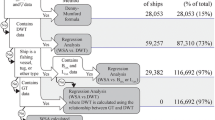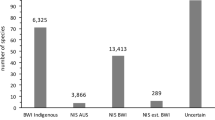Abstract
Invasive non-indigenous species are among the greatest threats to global biodiversity. Shipping is the principal vector for international dispersal of nonindigenous species, and shipping rates are increasing globally. The Australian government performs a range of regulatory actions to mitigate biosecurity risks associated with marine vessels, and in so doing has amassed a large volume of operational inspection data. This data can be used to quantitatively examine risk factors of vessels failing biosecurity procedures after arriving from international ports, the nature of biosecurity failures, and the types and seizure rates of biosecurity risk material (BRM). Classification trees with gradient boosting were used to assess characteristics that predict high risk vessels (n = 93,006) for carrying BRM, across 7 years of inspection data. Undeclared vessels and suspected irregular entry vessels posed the highest risk, but both were rare. Vessels that visit infrequently (<20 visits in 7 years) were common and had almost three times greater odds of failing inspection than vessels visiting frequently. On statistical analysis, yachts appeared to pose less risk than commercial vessels. In operational terms, a tentative profiled 20% fraction would contain 57% of genuine failures, and the concomitant non-screened group would contain 82% of passes. The most common reason for inspection failures was ballast water non-compliance (2.53%) and plant or insect detections (1.77%); biofouling was less common (0.13%) but testing for biofouling is not exhaustive. Invertebrate species comprised almost 90% of invasive organisms detected and seized from vessels failing biosecurity inspections. This study targets an entire transportation vector, which includes many pathways. Understanding the characteristics of transport vectors is pivotal to characterising the risk of biological invasions and applying adequate controls and prevention strategies. Our results show that biosecurity risk is not uniform on maritime pathways, so there is considerable scope for biosecurity regulators to impose risk-based intervention.


Similar content being viewed by others
References
Acosta H, Wu D, Forrest BM (2010) Fuzzy experts on recreational vessels, a risk modelling approach for marine invasions. Ecol Model 221:850–863
Bax N et al (2001) The control of biological invasions in the world’s oceans. Conserv Biol 15:1234–1246
Bax N, Williamson A, Aguero M, Gonzalez E, Geeves W (2003) Marine invasive alien species: a threat to global biodiversity Marine policy 27:313–323
Brockerhoff EG, Bain J, Kimberley M, Knížek M (2006) Interception frequency of exotic bark and ambrosia beetles (Coleoptera: Scolytinae) and relationship with establishment in New Zealand and worldwide. Can J For Res 36:289–298
Bureau of Infrastructure Transport and Regional Economics (BITRE) (2015a) Australian sea freight 2013–14. Department of Infrastructure and Regional Development, Canberra
Bureau of Infrastructure Transport and Regional Economics (BITRE) (2015b) Yearbook 2015: Australian infrastructure statistical report. Department of Infrastructure and Regional Development, Canberra ACT
Canyon D, Speare R, Naumann I, Winkel K (2002) Environmental and economic costs of invertebrate invasions in Australia. In: Pimentel D (ed) Biological invasions: economic and environmental cost of alien plant, animal and microbe species. CRC Press, London
Carlton JT (1996) Pattern, process, and prediction in marine invasion ecology. Biol Cons 78:97–106
Carlton J, Geller J (1993) Ecological roulette: the global transport of nonindigenous marine organisms. Science (New York, NY) 261:78–82
Carlton J, Reid DM, van Leeuwen H (1995) The role of shipping in the introduction of nonindigenous aquatic organisms to the coastal waters of the United States (other than the Great Lakes) and an analysis of control options report to US Coast Guard, Washington DC
Cope RC, Prowse TAA, Ross JV, Wittmann TA, Cassey P (2015) Temporal modelling of ballast water discharge and ship-mediated invasion risk to Australia. R Soc Open Sci. doi:10.1098/rsos.150039
Coutts AD, Taylor MD (2004) A preliminary investigation of biosecurity risks associated with biofouling on merchant vessels in New Zealand. NZ J Mar Freshw Res 38:215–229
DAWR (2017) The Vessel Compliance Scheme. http://www.agriculture.gov.au/biosecurity/avm/vessels/mars/vessel-compliance, version 6 January 2017. Accessed 29 May 2017
Endresen Ø, Behrens HL, Brynestad S, Andersen AB, Skjong R (2004) Challenges in global ballast water management. Mar Pollut Bull 48:615–623
Fernández-Delgado M, Cernadas E, Barro S, Amorim D (2014) Do we need hundreds of classifiers to solve real world classification problems? J Mach Learn Res 15:3133–3181
Floerl O, Inglis GJ (2005) Starting the invasion pathway: the interaction between source populations and human transport vectors. Biol Invasions 7:589–606
Floerl O, Inglis GJ, Hayden BJ (2005) A risk-based predictive tool to prevent accidental introductions of nonindigenous marine species. Environ Manage 35:765–778
Frey MA, Simard N, Robichaud DD, Martin JL, Therriault TW (2014) Fouling around: vessel sea-chests as a vector for the introduction and spread of aquatic invasive species Management of. Biol Invasions 5:21–30
Hayes KR (2003) Biosecurity and the role of risk assessment Invasive species: vectors and management strategies. Island Press, Washington DC, pp 382–414
Hewitt CL, Campbell ML (2007) Mechanisms for the prevention of marine bioinvasions for better biosecurity. Mar Pollut Bull 55:395–401
Hopkins GA, Forrest BM (2010) A preliminary assessment of biofouling and non-indigenous marine species associated with commercial slow-moving vessels arriving in New Zealand. Biofouling 26:613–621
Hulme PE (2009) Trade, transport and trouble: managing invasive species pathways in an era of globalization. J Appl Ecol 46:10–18
Inglis G et al. (2010) The biosecurity risks associated with biofouling on international vessels arriving in New Zealand: summary of the patterns and predictors of fouling. Technical paper. MAF Biosecurity New Zealand, Wellington, New Zealand
International Maritime Organisation (2012) International shipping facts and figures–information resources on trade, safety, security, and the environment. International Maritime Association, London
Keller RP, Drake JM, Drew MB, Lodge DM (2011) Linking environmental conditions and ship movements to estimate invasive species transport across the global shipping network. Divers Distrib 17:93–102
Lacoursière-Roussel A, Forrest BM, Guichard F, Piola RF, McKindsey CW (2012) Modeling biofouling from boat and source characteristics: a comparative study between Canada and New Zealand. Biol Invasions 14:2301–2314
Leung B, Lodge DM, Finnoff D, Shogren JF, Lewis MA, Lamberti G (2002) An ounce of prevention or a pound of cure: bioeconomic risk analysis of invasive species. Proc R Soc Lond B Biol Sci 269:2407–2413
Levine JM, D’Antonio CM (2003) Forecasting biological invasions with increasing international trade. Conserv Biol 17:322–326
Liu T-K, Tsai T-K (2011) Vessel traffic patterns in the Port of Kaohsiung and the management implications for preventing the introduction of non-indigenous aquatic species. Mar Pollut Bull 62:602–608
McCollin T, Brown L (2014) Native and non native marine biofouling species present on commercial vessels using Scottish dry docks and harbours. Management 5:85–96
Miller H, Clarke S, Lane S, Lonie A, Lazaridis D, Petrovski S, Jones O (2009) Predicting customer behaviour: The University of Melbourne’s KDD Cup report. In: Journal of machine learning research: workshop and conference proceedings, pp 45–55
Minchin D, Gollasch S (2003) Fouling and ships’ hulls: how changing circumstances and spawning events may result in the spread of exotic species. Biofouling 19:111–122
Molnar JL, Gamboa RL, Revenga C, Spalding MD (2008) Assessing the global threat of invasive species to marine biodiversity. Front Ecol Environ 6:485–492
Paini DR, Yemshanov D (2012) Modelling the arrival of invasive organisms via the international marine shipping network: a Khapra beetle study. PLoS ONE 7:e44589
Pilbara Ports Authority (2016) Port of Port Headland. Port Hedland, WA
Pimentel D, Lach L, Zuniga R, Morrison D (2000) Environmental and economic costs of nonindigenous species in the United States. Bioscience 50:53–65
Piola RF, McDonald JI (2012) Marine biosecurity: The importance of awareness, support and cooperation in managing a successful incursion response. Mar Pollut Bull 64:1766–1773
R Core Team (2014) R: A language and environment for statistical computing R foundation for statistical computing, Vienna, Austria. http://www.R-project.org/
Ricciardi A (2001) Facilitative interactions among aquatic invaders: is an” invasional meltdown” occurring in the Great Lakes? Can J Fish Aquat Sci 58:2513–2525
Ricciardi A, Neves RJ, Rasmussen JB (1998) Impending extinctions of North American freshwater mussels (Unionoida) following the zebra mussel (Dreissena polymorpha) invasion. J Anim Ecol 64:613–619
Ridgeway Gwcfo (2013) gbm: generalized boosted regression models R package version 20-8. https://cran.r-project.org/package=gbm
Roberts J, Tsamenyi M (2008) International legal options for the control of biofouling on international vessels. Mar Policy 32:559–569
Ruesink JL, Parker IM, Groom MJ, Kareiva PM (1995) Reducing the risks of nonindigenous species introductions. BioScience 45:465–477
Ruiz GM, Carlton JT, Grosholz ED, Hines AH (1997) Global invasions of marine and estuarine habitats by non-indigenous species: mechanisms, extent, and consequences. Am Zool 37:621–632
Seebens H, Gastner M, Blasius B (2013) The risk of marine bioinvasion caused by global shipping. Ecol Lett 16:782–790
Thresher RE (1999) Diversity, impacts and options for managing invasive marine species in Australian waters Australian. J Environ Manag 6:137–148
Vitousek PM, D’Antonio CM, Loope LL, Westbrooks R (1996) Biological invasions as global environmental change. Am Sci 84:468–478
Williams R, Griffiths F, Van der Wal E, Kelly J (1988) Cargo vessel ballast water as a vector for the transport of non-indigenous marine species Estuarine. Coastal Shelf Sci 26:409–420
Wonham MJ, Walton WC, Ruiz GM, Frese AM, Galil BS (2001) Going to the source: role of the invasion pathway in determining potential invaders. Mar Ecol Prog Ser 215:1–12
Acknowledgements
The authors would like to thank the Australian Federal Department of Agriculture and Water Resources (DAWR) for providing the data and motivation for this study. This research was supported by the Centre of Excellence for Biosecurity Risk Analysis, University of Melbourne.
Author information
Authors and Affiliations
Corresponding author
Rights and permissions
About this article
Cite this article
Clarke, S., Hollings, T., Liu, N. et al. Biosecurity risk factors presented by international vessels: a statistical analysis. Biol Invasions 19, 2837–2850 (2017). https://doi.org/10.1007/s10530-017-1486-1
Received:
Accepted:
Published:
Issue Date:
DOI: https://doi.org/10.1007/s10530-017-1486-1




